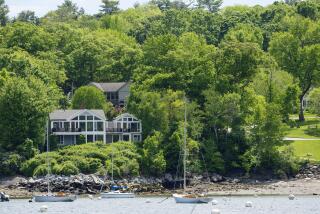Q&A: Wild edible plants pose liability risks to homeowner association
- Share via
Question: Some areas of our very mature development have creeks, streams, trees and dense vegetation similar to forested areas where wild edible delicacies are usually foraged. None of these delicacies were planted by the association, and because of their unique flavors, they’re considered culinary delights. These free treats are all the more attractive because no dogs are allowed in this area and the association uses no pesticides. We hired 24-hour roaming security guards to prevent theft, but the cost was outrageous.
We have ostrich fern, or Matteuccia Struthiopteris, that stays green year round with little care and is free from disease and pests. These ferns thrive on recycled leaf mulch from our other trees, making them cost-effective landscape. Unfortunately they are also a very popular delicacy: fiddleheads. They are bright green, tightly wound curled fronds on a thick stem, prized for their high nutritional content and incomparable taste. One fern can produce about six to nine fronds per growing season. Our owners are not environmentally conscious and harvest more than the plant can withstand, thus jeopardizing survival of the fern. They pick off so many fiddleheads it stunts plant regrowth. Many ferns look similar and some are highly poisonous. Fiddleheads harbor microorganisms and must be thoroughly washed and well cooked. The brown, papery covering must be removed before cooking and it can never be eaten raw or even lightly sautéed.
Wild fennel is abundant and reproduces easily, growing to 5 feet; it’s also an aromatic herb. Nothing on this plant goes to waste. Owners harvest the greens, flowers, seeds and bulbs. Some call it a weed, yet it’s impossible for us to eradicate, so we’ve embraced it as part of our landscape; its additional feature is a year-round fragrance.
The base of some of our trees have wild morel mushrooms; then there’s wild ramp, a garlic/leek vegetable combination that blankets the ground. Both are sought-after ingredients by high-end restaurants.
No homes abut these forested areas, so the public has access. To remove the wild delicacies would be labor intensive and prohibitively costly, as would fencing, which would apply only to those living outside the development. Even if possible, removing the forested areas could substantially devalue our development. Some owners want to leave things as they are, others want hands off forested areas. Even though no one’s sued the association, as a director I’m worried that a lot of things can go wrong. How should the board handle this?
Answer: A non-cookie-cutter development that is cost-effective, with exotic landscaping, can be a great benefit to the association, increasing the value of all property and aesthetic appeal of the community as a whole, while adding a dimension of interest and unique appeal. But you are right to be nervous if there is a danger of poison and liability to your development and its owners.
Associations are required to remove dangerous conditions and take reasonable steps to ensure owners and visitors (whether invited or trespassing) are warned of potential danger, especially those that are not easily visible or widely known.
Completely removing this landscape may not be in the best interest of the association, especially if whatever replaces the current vegetation requires pesticides or costly maintenance.
Examine the possibility of whether well-lighted signs can be installed that reasonably warn visitors of potentially hazardous property conditions, including ingesting the plants. Placing a fence around all, or a portion, of this area may not completely prevent access, but coupled with signs alerting of poisonous vegetation, there is a reasonable expectation that passersby and visitors are on notice this is private property.
Consider adopting rules regarding the taking and using of harvested vegetation belonging to the association. Such rules should address damaging plants and overharvesting. If owners and their guests are picking plants for sale or incorporating ingredients into food items given to third parties, there may be resulting liability for the association if anyone is harmed. Sales of these delicacies should be prohibited with signs warning that vegetation in general carries microorganisms requiring special handling and preparation.
Similarly, discuss a waiver or “hold harmless” agreement for owners to sign waiving any liability on the association’s part for the use and enjoyment of this area and its plants. While this may not completely absolve the association of all potential liability, it is one additional document to present as evidence of notice of damage in the event of a lawsuit.
A risk analysis balances costs such as insurance premiums, potential litigation and the task’s difficulty versus benefits to the community. Fortunately no one has sued yet. But for every property condition posing a threat it is the board’s duty to mitigate damages. Where a board fails to consider the best course of action and where damages could have been avoided through reasonable efforts, the association may not escape liability.
Zachary Levine, partner at Wolk & Levine, a business and intellectual property law firm, co-wrote this column. Vanitzian is an arbitrator and mediator. Send questions to Donie Vanitzian JD, P.O. Box 10490, Marina del Rey, CA 90295 or [email protected].
More to Read
Sign up for Essential California
The most important California stories and recommendations in your inbox every morning.
You may occasionally receive promotional content from the Los Angeles Times.






